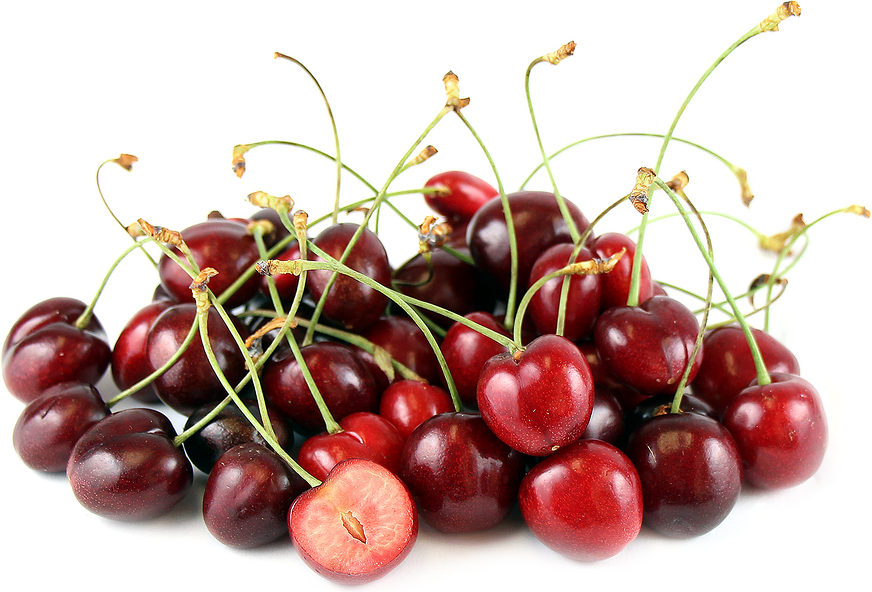


Minnie Royal Cherries
Estimated Inventory, lb : 0
Description/Taste
Minnie Royal cherries are small to medium in size, averaging around two centimeters in diameter, and have a uniform, round to slight cordate shape. The fruit’s skin is glossy, smooth, taut, and semi-thick, bearing bright red to crimson hues. The fruits are also attached to elongated, slender, and fibrous green stems reaching up to five centimeters in length. Underneath the surface, the flesh ranges in color from light red to pink and is moderately juicy with a firm and crisp, snap-like consistency. There is also an oblong to round, tan pit that is firmly adhered to the flesh. The pit should be discarded and not consumed. Minnie Royal cherries average around 18 Brix, a measurement of the sugar content, developing a sweet-tart taste with finishing flavors of rhubarb, cranberry, and red currant.
Seasons/Availability
Minnie Royal cherries are available in the late spring.
Current Facts
Minnie Royal cherries, botanically classified as Prunus avium, are an early-ripening variety belonging to the Rosaceae family. The modern, low-chill cultivar grows on large trees that can reach 3 to 4 meters in height and are favored by growers for the fruit’s sweet-tart flavor. Minnie Royal cherries are a versatile variety, grown in both warm and cool climates, and the trees are heavy producers, developing early-season fruits that are durable for export. The cultivar is also one of the first cherries to ripen in the late spring, and the fruits are consumed fresh or utilized in a wide array of cooked preparations.
Nutritional Value
Minnie Royal cherries are a good source of potassium to balance fluid levels within the body and calcium to protect bones and teeth. The fruits are also a source of vitamin A to maintain healthy organ functioning, vitamin C to strengthen the immune system, and other antioxidants to reduce inflammation and guard the cells against free radical damage.
Applications
Minnie Royal cherries have a unique, sweet-tart flavor well suited for both savory and sweet preparations. When raw, Minnie Royal cherries can be consumed straight, out of hand, discarding the seed, or they can be used as a topping over yogurt, acai bowls, and ice cream. The cherries can also be sliced and tossed to salads, chopped into salsa, mixed into slaws, or stirred into grain bowls. In addition to fresh preparations, Minnie Royal cherries can be simmered into sauces for roasted meats, cooked into jams, jellies, and compotes, juiced for syrups, or incorporated into fillings for baked goods, including turnovers, tarts, cakes, cinnamon rolls, and crème brulee. The firm nature of Minnie Royal cherries also allows the fruits to hold their shape in crisps, crumbles, cheesecakes, and pies. Beyond culinary dishes, the cherries can be blended into smoothies or juiced into cocktails, mixed drinks, and fruit punches. Minnie Royal cherries pair well with other fruits such as plums, limes, oranges, apricots, and nectarines, nuts including pistachios, pecans, and almonds, spring onions, beets, cilantro, sage, meats such as beef, pork, poultry, venison, and duck, dark chocolate, vanilla, balsamic vinegar, and cheeses such as feta, cheddar, and ricotta. Whole, unwashed Minnie Royal cherries will keep up to one week when stored between paper towels in the coldest part of the refrigerator. The cherries can also be frozen for extended use.
Ethnic/Cultural Info
Minnie Royal cherries are a contemporary cultivar selectively bred to have a low chilling requirement. Cherry trees traditionally need hours of cold weather in the fall and winter season to enter a state of dormancy. Cooler temperatures trigger hormones within the tree to become dormant, and the neutral state allows the trees to conserve energy for the following growing season. Each cherry variety has a different chilling requirement, but on average, most cherry trees need 800 to 1,200 hours. Minnie Royal cherries only need 400 to 500 hours, having one of the lowest chill time requirements. This advancement in breeding has allowed cherry production in traditionally too warm regions, including Southern California, Arizona, and Florida. In home gardens, Minnie Royal cherries are often planted with royal lee cherries for pollination, and both varieties are early-season low-chill cultivars.
Geography/History
Minnie Royal cherries were developed by Zaiger genetics in their experimental orchard near Modesto, California, in the late 20th and early 21st century. The variety was created from open-pollination, and within its lineage, several non-patented, unnamed varieties contributed to the cultivar. Minnie Royal cherries were also bred and selected for production through a team of scientists, including Chris Zaiger, Grant Zaiger, Leith Gardner, and Gary Zaiger. The variety was submitted for a patent in 2000 and was granted the patent in 2002 under the US Plant Patent #12942. This patent was said to have expired in 2020, but many garden centers still regard the variety as a proprietary cultivar. Today Minnie Royal cherry trees are primarily grown in home gardens and through specialty growers. When in season, the fruits are sold through local farm stands, markets, distributors, and select grocers.
Podcast




